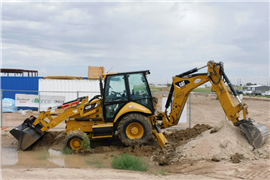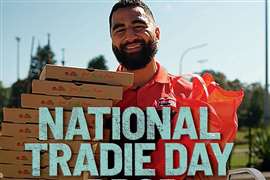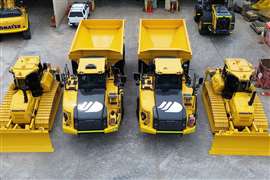Roundtable: Why compact telehandlers are today’s tool of choice
13 May 2024
Fueled by favorable market headwinds, construction activity across the US has created a growing demand for telehandlers on jobsites. Lindsey Anderson provides an in-depth look into the latest trends and drivers, with a focus on compact units.
Telehandler sales soared in the US last year, according to a new study published by Off-Highway Research (OHR).
Dubbing 2023 a “peak year for construction equipment sales,” OHR said strong underlying market drivers such the IIJA, CHIPS Act and numerous mega projects saw activity surge across the country, and along with it, climbing construction equipment sales.
“In the US, growth was robust and most of the individual product categories saw increased sales,” says OHR Global Managing Director Chris Sleight. “But the standout in terms of both growth and volume was the telehandler.”
Total construction machinery sales for the year topped 305,000 units, up 8% year-over-year, marking the third consecutive record year for construction equipment sales – and the first time ever that more than 300,000 construction machines were sold in the US. According to OHR, telehandler sales rose by more than a third, with 30,000 units coming to market, representing nearly 10 percent of total machine sales.
“The versatility of these machines and their application across both residential and nonresidential building put them in the sweet spot for growth,” Sleight adds. “It seems inevitable that 2023 will be the high-tide mark for the U.S. equipment market for this cycle.”
And manufacturers couldn’t agree more. ALH spoke with telehandler OEMs to get their take on trends, market expectations and new product launches within the compact telehandler segment. Here’s what they had to say.
ALH: How is today’s overall North American market fairing for compact telehandlers? How do you see it playing out for the remainder of the year?
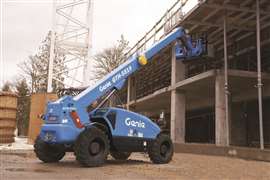
Keith Hovey, head of global marketing, Genie: The market for compact telehandlers continues to be strong and growing. There really are two things happening at the same time to drive adoption. The first is that, more and more, people are realizing the value of having a telehandler on their jobsite; as a result, more people are using them. The second is the ongoing need for new and upgraded infrastructure, and the ongoing investments in infrastructure. So, not only are telehandlers a staple on more jobsites, there are also more jobsites in general. For that reason, we expect demand will remain strong.
Lee Tice, product manager, JCB: If we look at what happened from, we’ll just say 2022 to 2023, the compact telehandler market almost doubled. So, market size grew tremendously from ‘22 to ‘23. We really see that continuing into 2024. We haven’t seen anything that’s going to indicate a market shift or slowdown in this compact sector and really contribute that growth to some of these infrastructure bills. The residential and related housing markets have kind of exploded, and commercial construction’s taking place all across North America – and that’s really where these machines shine. I think also more customers are realizing the benefits of compact telehandler and the ability to not only perform as a telehandler, but also the ground engagement.
John Boehme, senior product manager – telehandlers, JLG: The overall market demand for smaller, versatile equipment like compact telehandlers is very robust right now with all the
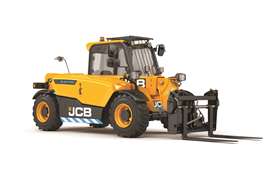
infrastructure projects starting up this spring and summer. This means that the largest user of compact telehandlers continues to be general construction contractors.
That said, the applications for these compact machines vary greatly from the initial phases of a large construction project, where the machines can be found unloading trucks and delivering materials, to the closing stages, where they can be utilized for job site cleanup and landscaping. So, other big users of this size of telehandler are landscapers and hardscapers.
Other markets/applications that will often rent compact telehandlers include industrial and residential construction, commercial and retail operations, refurbishment and reconstruction

projects, parking garage construction and event set-up and teardown, as well as a wide variety of maintenance work.
The market opportunities for compact telehandlers in agricultural applications, by farmers and ag producers, are also growing.
Steve Kiskunas, product manager — telescopic handlers, Manitou: Overall demand is increasing — more compact telehandlers are being sold into the North American region across a number of markets. Part of the increased demand is because these compact units make telehandlers much more accessible – contractors who previously thought they could not afford a telescopic telehandler now realize it can be more practical and affordable than ever before.
We see excellent demand with these machines in homebuilding and related industries, such as concrete contractors. The ability to load and unload trucks, pick and place materials in an all-terrain environment is key. They are also ideally suited for rental because they are easy to own and operate, easy to transport, and flexible for many uses. These are great in landscaping because of the all-terrain capabilities, and the ability to use skid steer and CTL attachments interchangeably. These machines also provide excellent power with rubber tires that make them a strong option for snow pushes — and the telescoping abilities help with stockpiling. The auxiliary hydraulic capabilities make them a great option for sweepers as well.
Malcolm Early, vice president – marketing, Skyjack: They have become increasingly popular in recent years due to their ability to navigate in smaller areas, making them a great choice for indoor projects or outdoor job sites with limited space. 2023 saw sustained market growth that meant that levels were very much back to pre-covid levels.
Robby Hagan – senior vice president of sales, Xtreme Manufacturing / Snorkel: Both Xtreme and Snorkel have an increase year-over-year in order intake for compact machines. Many
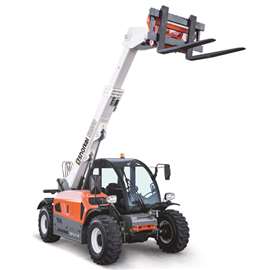
general rental companies that wish to participate in the telehandler forklift rental market utilize the compact telehandlers as a point of entry. Often these smaller rental companies do not wish to include semi-truck and trailers into their delivery fleet as they are costly due to the acquisition, driver, and maintenance costs.
ALH: What are the biggest trends in the North American compact telehandler sector today?
Jamison Wood, product development specialist, Bobcat Company: Some of the notable trends in the North American compact telehandler sector include an increasing emphasis on
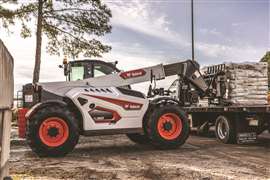
telematics features to enhance productivity and efficiency. The growing adoption of telematics systems enables remote monitoring of machine health, performance, and location, allowing rental companies to optimize fleet management and maintenance schedules. [Also], an increased focus on ergonomics means these units are coming equipped with more comfortable cabs, intuitive controls and improved visibility for the operator.
Hovey: There are really three trends: Increasing versatility through attachments; electrification; and the total cost of ownership.
Telehandlers are already popular tools on a wide range of jobsites as a result of their versatility. Attachments allow these machines to be used for even more tasks, expanding their utilization. One example is the auger attachment Genie introduced at ARA for the GTH-5519 compact telehandler. Especially when there are obstructions like a ditch, the GTH-5519 with the auger attachment is the perfect choice for drilling holes because you can extend the boom to reach over the ditch, which isn’t possible with other types of equipment.
The second trend, as discussed above, is electrification. Our priority at Genie is to provide support for our customers that are keen on electrifying their fleets, while also making sure any electrified solution we introduce meets the high standards of equipment owners in terms of quality and total cost of ownership. Our goal is to address the existing pain points that are hindering widespread adoption to help facilitate a smoother transition to electrification.
And finally, the third trend is toward looking at total cost of ownership. Equipment owners understand that it’s not just the initial purchase price that matters when growing their fleets, because the value of that machine really comes from what it adds to their business during the life of the machine. That value is created through utilization rates and residual value. It also includes factors like maintenance, and how much it costs — in money and downtime — to own the machine. One of the reasons the GTH-5519 is a popular choice when it comes to compact telehandlers is that it has high utilization rates while being durable and easy to maintain, with a strong value on the used market, providing a lower total cost of ownership.
Boehme: One trend we see in the compact telehandler sector today is these machines are being used more and more in urban and suburban applications compared to larger models, or other types of equipment, is that they have a small footprint but still offer plenty of power. For example, trucks still need to be loaded/unloaded on job sites in space-restricted downtown areas, and when contractors need to move job site materials from place to place, they have to have equipment that fits on the road and can maneuver around various obstacles.
Kiskunas: You are seeing overall greater consideration and adoption of compact telehandlers, which is evident by the speed in which they leave our dealer lots upon arrival. Old stigmas around “traditional” equipment categories seem to be going by the wayside more and more each day to the point where people will test and consider product categories that they might not
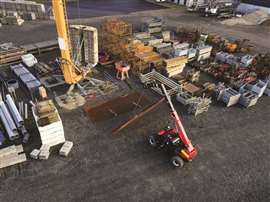
be as familiar with.
While no one talks about emissions as much anymore, you still see a preference towards 74 horsepower machines when possible to avoid diesel exhaust fluid and to keep emissions control as hands-off as possible. Operator comfort and user experience are just as important in compact telehandlers as they are in more full-sized equipment. And with project costs and material costs being what they are, business owners and fleet managers are spending more time analyzing what the addition of a piece of equipment does to their carrying costs and their total cost of ownership over the life of a machine — and the versatility of a compact telehandler delivers application flexibility that ensures a high rate of utilization and profitability. It’s a multipurpose machine that can help you reduce the need for other machines.
Early: Any technology that contributes to drive ROI will be popular in 2023. Machine reliability and longevity, as well as flexibility for fleet movement, are increasingly important.
Skyjack’s telehandlers use SKYCODED, a proven and simplistic control systems using our color coded and numbered wiring system to make our machines the easiest to troubleshoot. Using a relay-based control system allows Skyjack’s telehandlers to operate with simpler components resulting in less maintenance and lower costs.
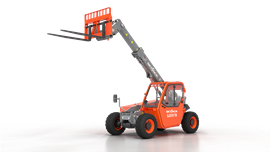
Advances that incorporates flexibility, such as FLEXCAB, will also be impactful in the coming years to allow for fast response to rental customer demands. FLEXCAB is an innovative cab design that allows fleet operators to easily convert between open and enclosed cabs with simple hand tools, providing increased flexibility for fleet movement and fast response to customer demands.
Hagan: There is a growing interest in Lithium-ion as the battery market is maturing. Other trends include more options such as cabs, carriages and fork sizes, as well as offering a large range of attachments and accessories.
Due to their size, compact telehandlers make good candidates for hybrid power/electrification. Do you see this size category as a viable ‘green’ machine? Why or why not?
Wood: There continues to be an increase in offering compact equipment with alternative power. As technology advances and alternative power options become more readily available the number of machines being considered “green” should increase.
Hovey: The trend in our industry continues to be toward electrification, particularly when you’re talking about smaller machinery such as scissor lifts and compact booms. But, when you’re talking about more demanding equipment like telehandlers, there’s really a varied landscape in terms of the adoption of electrification. It’s a little bit like the auto industry and electric vehicles. You’ve seen the early adopters already moving toward electrification. But, not everyone is ready yet.
One reason is that internal combustion telehandlers are used on every type of jobsite, from new construction all the way through to tenant improvements, so the availability of charging infrastructure varies. So the industry still needs to solve for how they’re going to provide power to these machines throughout different phases of the job.
The second factor is financial. The technology needs to advance to a point where you can get the same performance at a price point that makes sense in terms of the total cost of ownership. In other words, the acquisition price, which is typically higher for electrified equipment, needs to be offset by things that reduce the total cost of ownership, like reduced maintenance.
Tice: JCB has obviously embarked on the zero emissions journey and the compact products we believe are a really good fit for this kind of class size of machine. And you kind of touched on some of the points there with getting power to jobsites and things like that where compact products are typically the machine that’s behind the contractor’s truck or they’re ones that we take home in the evening.
So, compact machines aren’t being dropped off on job sites and remain on the jobsite for the full length of the product. These are products that are typically traveling with the contractor or the customer, the end user. So that’s why we think they’re a very good fit for electrification. And when you look at the electric products, it’s really based on looking at compact equipment as ‘the automobiles of the electric industry.’
Automobiles seem to be doing very well with electrification, but when you start getting up into the mid-range equipment, some of your backhoes, large telehandler, things like that, these would be more compared to our say, semis, larger trucks, delivery vehicles, things like that, where electrification may not be the answer. So we do have an electric 5 5, we do see it as a good fit in the compact industry and does very well with electrification, giving the operator all of the same benefits or performance that he would get from a diesel counterpart. So, no loss in performance by going to electric, you still get the full eight-hour runtime of telehandler use. So, we do see it as being a very good fit for the electric market.
Boehme: Industry-wide, customers are asking for more electrified equipment solutions, and yes, we believe that electrification of compact telehandlers is viable and will continue to evolve with advancing technologies.
Kiskunas: We see telehandlers in the compact size class as very viable for electrification, and have select units in the category that are available as electric models. These machines are often not working at a “production” pace, and because of that many applications will be able to get by with a whole day of work, and then allow it to recharge overnight. Many of these units may be used for either indoor work in large warehouse construction, or need to drive indoors or even be used underground – so the lack of diesel engine emissions is advantageous. There are also lifetime total cost of ownership advantages to electrified machines when you factor in the elimination of fuel and other maintenance items related to a combustion engine.
Early: Electrification, whether by hybrid of full electric technology is a discussion topic currently. Although it’s not the only alternative - telehandlers are more open to hydrogen based technologies since their use pattern allows for longer engine use, versus aerials for example where intermittent engine use tends to mitigate against hydrogen use. These alternatives may well have a place longer term although I would say that within North America the short term future is with the traditional ICE.
Hagan: The Snorkel SR5719E is equipped with a 300ah (400ah Option) lithium-ion battery package. The applications vary between food processing facilities, municipalities, and many other sensitive areas such as bodies of water. Not a fan of Hybrid. We prefer to go full Lithium-ion.
What are the most-recent design/engineering updates or changes that your company has made to its compact telehandler line? Why were these implemented?
Wood: Current machines are equipped with several features not previously offered including our smart handling system, boom cushioning, advanced attachment control mode, and much more.
Hovey: When we designed the GTH-5519, it was done purposefully so that it would be a durable, reliable, easy-to-own piece of equipment. Since its introduction, it has been extremely popular, so any changes have been small and incremental, in line with our commitment to continuous improvement and our Quality By Design brand promise.
Where the bigger changes have occurred is with attachments. At ARA, Genie introduced an auger attachment, which was designed specifically for the GTH-5519, but also is compatible with skid steers. Our customers have responded well to the attachment, because it does increase versatility, which has a positive impact on utilization rates.
Boehme: Last year, JLG began the process of redesigning its popular SkyTrak telehandler line, starting with the all-new 6034 and 6042 models. Understanding the demands and challenges crews face on work sites day after day, JLG engineered the 6034 and 6042 models with features and capabilities to deliver customers’ most requested features, with zero sacrifice. Featuring a redesigned build, reworked functionality, reimagined technology and refocused serviceability, these 6,000-pound maximum lift capacity telehandlers are ideal for pick-and-place applications, such as handling, loading and unloading bulk materials on demanding residential, commercial, urban and suburban job sites across America.
The brand-new 6034 telehandler replaces the previous 6036 model, while the 6042 telehandler has been updated with new features inspired by the way customers work. The design of the 6034 and 6042 models emphasizes convenience and productivity. These newly updated SkyTrak telehandlers both feature a new advanced control system that allows for more options like load stability indication (LSI), seatbelt engagement and operator presence (SEOP), along with improved diagnostics. The new cab design features a larger LCD display for a more data-rich interface and larger, single-page load charts for added convenience.
Productivity and operator confidence go even further with several optional systems. The optional multi-reverse camera system lets operators backup with confidence by displaying multiple views from behind the machine to the left, right and rear. This system can be used during the day and night, and it features four components: Left and right-side backup cameras, a rear backup camera and a tri-view monitor.
Kiskunas: We’ve focused on that kind of versatility with the introduction of the new MTA 519 compact telehandler. The use of a skid steer quick attach system makes it extremely versatile. The cab is large for a compact machine and is extremely operator-friendly, and the controls are very intuitive and are comparable to those of a large machine.
While it’s a compact machine, we’ve built it in a very robust way to hold up against the stresses of the jobsite, including a ground-engaging boom that features the same thickness on the sides of the boom as on the top and bottom of the boom to ensure strong performance when using buckets and attachments. We’ve mounted the boom low for better visibility. We have excellent ground clearance for off-road operation. And the engine is incorporated into the machine in a way that also allows for a low hood for excellent visibility, and easier access to service points to assist in better daily service practices and lower lifetime total cost of ownership.
Another thing we did with this new model was that we pre-loaded our parts network to ensure easy access to parts from the first day the machine was available to ensure speedy parts delivery and assist in uptime.
Early: Initially launched in 2015 and updated in 2021, Skyjack offers six models of telehandlers throughout North America, including the compact SJ519 TH. Recent updates have increased the return on our customers’ investment by building upon reliability and serviceability, a direct result of customer and operator feedback. Skyjack’s latest range of telehandlers feature two unique systems.
First, a Rear Axle Stabilization (RAS) system that increases stability and provides jobsite flexibility with three operational modes: normal free pivot, restricted, and locked.
Based on the boom angle the RAS system kicks in automatically allowing the operator to perform fine tuning adjustments to place the load safely at height without having to lower the load to level the frame and then lift again.
Second, SMARTORQUE allows Skyjack’s TH Series’ 74 hp engines to deliver the same on-site job performance as higher horsepower units. The improved gearing and high-efficiency hydraulics package does not require DPF, DEF or other active exhaust treatment, thus reducing operating costs.
Hagan: The biggest engineering changes would surround the successful design and deployment of the lithium-ion equipped compact telehandlers. Many lessons are learned while implementing additional options for a customer to consider. We are now transferring our compact telehandler knowledge and feedback into large machine designs. Stay tuned!
STAY CONNECTED



Receive the information you need when you need it through our world-leading magazines, newsletters and daily briefings.
CONNECT WITH THE TEAM










